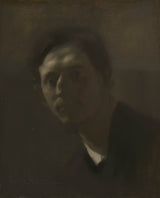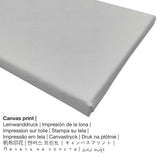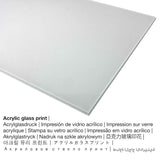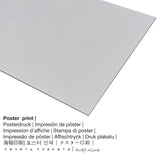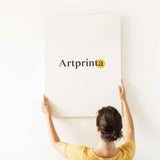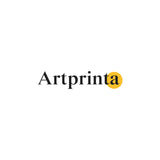Eugène Carrière, 1891 - Armand Berton - mbipụta nka mara mma
Ụtụ gụnyere. Mbupu gbakọrọ na ndenye ọpụpụ.
Original artwork specifications from The Cleveland Museum of Art (© - The Cleveland Museum of Art - www.clevelandart.org)
Associated with the 19th-century Symbolist movement in France, Carrière developed a distinctive, almost monochromatic palette suggesting a dream world. The limited color in this portrait of his friend, the deaf painter Armand Berton, also focuses attention on the psychology of the sitter. Translucent glazes make Berton's face emerge from the shadows. Engulfed in silence, Berton seems to rely on his other senses to perceive the world around him.
Nkọwapụta nka nka
| Akụkụ nka: | "Armand Berton" |
| nhazi ọkwa: | sere |
| Okwu mkpokọta: | nkà nke oge a |
| Century: | 19th narị afọ |
| Emepụtara n'afọ: | 1891 |
| Afọ nka: | ihe karịrị afọ 120 |
| Ihe osise izizi: | mmanụ na akwa ákwà |
| Akụkụ nke ihe osise izizi: | Nhazi: 62,2 x 54 x 7,6 cm (24 1/2 x 21 1/4 x 3 na); Emebereghị: 46 x 38 cm (18 1/8 x 14 15/16 na) |
| Akara aka na nka nka: | signed in paint at lower left: Eugène Carrière |
| Ụlọ ihe ngosi nka: | Velọ ihe ngosi nka nke Cleveland |
| Ebe ngosi nka: | Cleveland, Ohio, United States nke America |
| Ebe nrụọrụ weebụ ihe ngosi nka: | Velọ ihe ngosi nka nke Cleveland |
| Licensedị ikike: | ngalaba ọha |
| Site n'aka: | Velọ ihe ngosi nka nke Cleveland |
| kreditline ọrụ nka: | Arịrịọ nke Noa L. Butkin |
Tebụl onye na-ese ihe
| Ihe nkiri: | Eugène Carrière |
| okike nke onye nka: | nwoke |
| Obodo onye nka: | French |
| Ọrụ onye na-ese ihe: | onye na-ese ihe |
| Mba onye si: | France |
| nhazi ọkwa: | omenkà nke oge a |
| styles: | Ihe ngosi |
| Nwụrụ anwụ: | 57 afọ |
| Afọ ọmụmụ: | 1849 |
| Amụrụ na (ebe): | Gournay-sur-Marne |
| Afọ ọnwụ: | 1906 |
| Nwụrụ na (ebe): | Paris |
Nkọwapụta ngwaahịa
| Ụdị edemede: | nka nka |
| Mmeputakwa: | mmeputakwa n'ụdị dijitalụ |
| Produzọ mmepụta: | Mbipụta UV ozugbo |
| Mmalite nke ngwaahịa a: | emere na Germany |
| Stockdị ngwaahịa: | mmepụta ihe na-achọ |
| Ihe eji eme atụmatụ: | mgbidi mgbidi, ụlọ ihe osise nka |
| Ndozi onyonyo: | nhazi ihe osise |
| Njikwa oyiyi: | 1: 1.2 - ogologo: obosara |
| Mmetụta akụkụ: | ogologo bụ 20% mkpụmkpụ karịa obosara |
| Akụrụngwa ị nwere ike ịhọrọ: | Mbipụta iko acrylic (nwere ezigbo mkpuchi iko), mbipụta ọla (aluminium dibond), mbipụta akwa akwa, mbipụta akwụkwọ mmado (akwụkwọ kwaaji) |
| Mbipụta kanvas (akwa akwa na etiti ihe ndọtị): | 50x60cm - 20x24", 100x120cm - 39x47", 150x180cm - 59x71" |
| Mbipụta iko acrylic (nke nwere ezigbo mkpuchi iko): | 50x60cm - 20x24", 100x120cm - 39x47" |
| Ụdị akwụkwọ mmado (akwụkwọ kwaaji) dị iche iche: | 50x60cm - 20x24", 100x120cm - 39x47" |
| Nhọrọ mbipụta aluminom: | 50x60cm - 20x24", 100x120cm - 39x47" |
| ụba: | na-enweghị etiti |
Ihe ndị a na-ahọrọ
Anyị na-enye ihe dị iche iche dị iche iche na nha maka ngwaahịa ọ bụla. Ya mere, anyị na-enye gị ohere ịhọrọ n'ime nhọrọ ndị a:
- Mbipụta enyo acrylic: The acrylic glass print, often referenced as a print on plexiglass, changes your favorite artwork into stunning wall decoration. In addition to that, the acrylic print offers a great alternative option to canvas or dibond fine art replicas. Your own replica of the artwork is being custom-made with modern UV print technology. The major benefit of a plexiglass fine art copy is that contrasts as well as details will be more exposed thanks to the fine gradation.
- Mbipụta kanvas: A canvas print is a printed cotton canvas stretched on a wooden stretcher. A canvas produces the plastic effect of three-dimensionality. Canvas prints are relatively low in weight. That means, it is easy to hang your Canvas print without the support of any wall-mounts. Because of thata canvas print is suitable for all kinds of walls.
- Aluminom dibond (ọkpụkpụ ọla): These are metal prints on aluminium dibond material with an impressive effect of depth, creating a fashionable look thanks to a non-reflective surface. For the Direct Aluminium Dibond print, we print the chosen artwork on the aluminium composite white-primed surface. The colors are luminous and bright in the highest definition, the fine details are crisp. The direct print on aluminium is the most popular entry-level product and is a truly sophisticated way to showcase art prints, since it puts 100% of the viewer’s attention on the replica of the artwork.
- Mpempe akwụkwọ mmado ebipụtara na akwa akwa: A poster is a printed canvas paper with a slight texture on the surface. Please bear in mind, that depending on the absolute size of the canvas poster print we add a white margin between 2-6cm around the painting, which facilitates the framing.
Nchịkọta ngwaahịa
The nkà nke oge a nka nka Armand Berton e kere ya Eugène Carrière in 1891. The piece of art has the following dimensions - Framed: 62,2 x 54 x 7,6 cm (24 1/2 x 21 1/4 x 3 in); Unframed: 46 x 38 cm (18 1/8 x 14 15/16 in). Mmanụ na akwa ákwà was used by the European painter as the technique for the artpiece. "Signed in paint at lower left: Eugène Carrière" was the artpiece's inscription. What is more, this work of art is in the the art collection of The Cleveland Museum of Art, which is one of the leading museums worldwide that builds, preserves, studies, and shares its outstanding collections of art from all periods and parts of the world, generating new scholarship and understanding, while serving as a social and intellectual hub for its community. This nkà nke oge a artwork, nke bụ nke ngalaba ọha is provided with courtesy of The Cleveland Museum of Art. Creditline of the artwork: Bequest of Noah L. Butkin. In addition to this, the alignment is in Eserese format ya na oke nke 1: 1.2, which implies that the length is 20% shorter than the width. The painter Eugène Carrière was a European artist, whose artistic style can be classified as Realism. The European artist was born in 1849 na Gournay-sur-Marne wee nwụọ mgbe ọ dị afọ 57 n'afọ 1906.
Ihe dị mkpa: We do to describe the products as accurately as possible and to display them visually in our shop. Still, some colors of the print materials, as well as the printing might vary somehwat from the presentation on your device's screen. Depending on the screen settings and the condition of the surface, not all color pigments will be printed 100% realistically. In view of the fact that all fine art prints are processed and printed manually, there might as well be slight discrepancies in the motif's exact position and the size.
Nwebiisinka © - Artprinta.com

